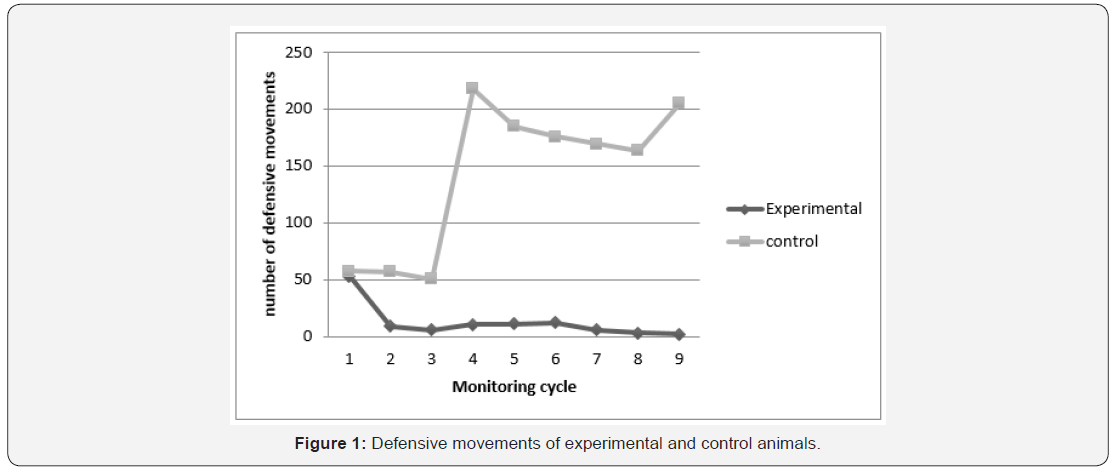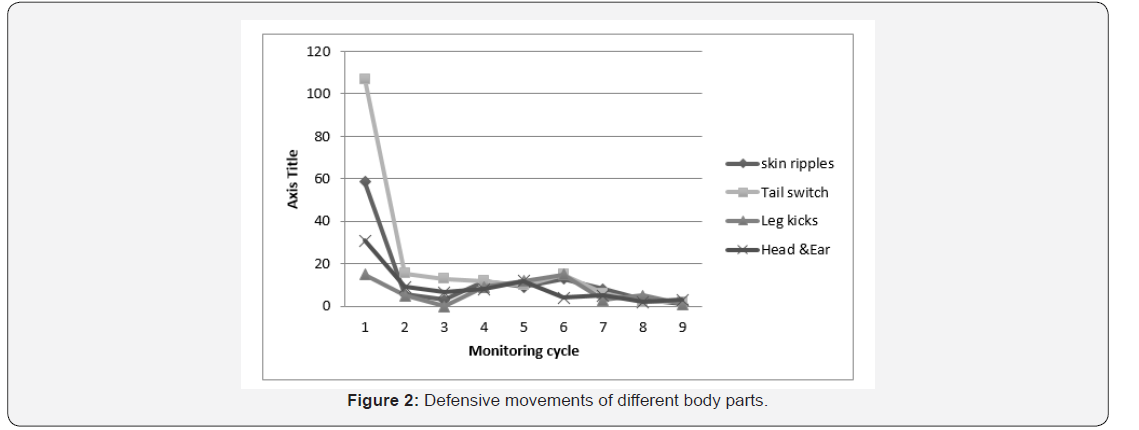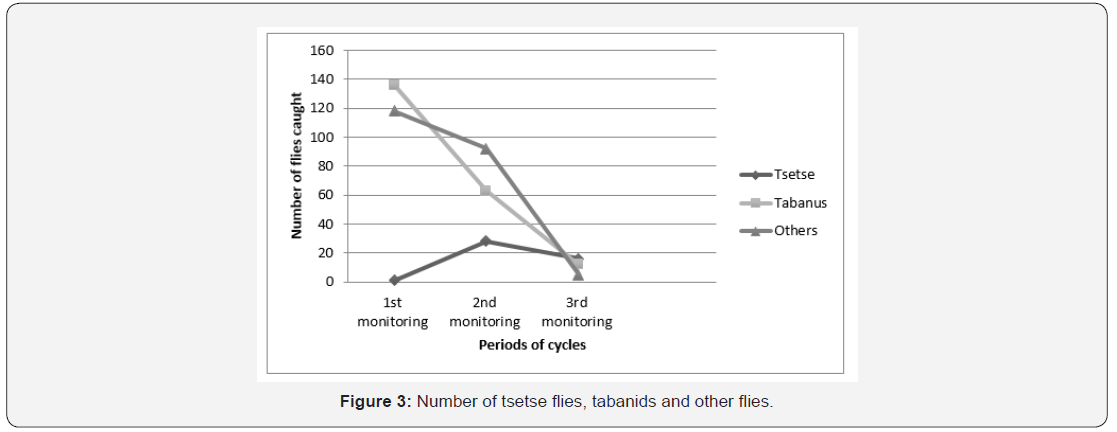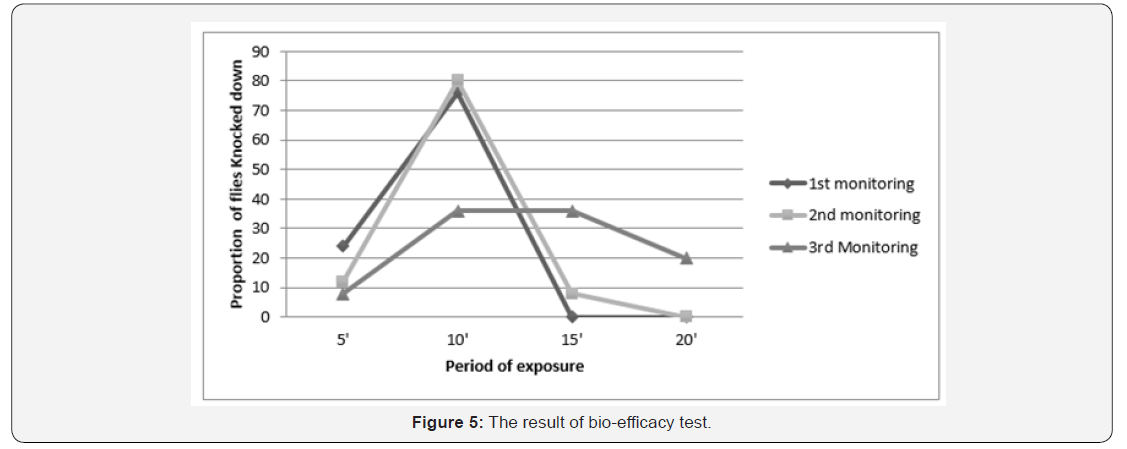Evaluation of 0.4% Deltamethrin Treated Net Encircled around Cattle Pen in Protecting Animals from Tsetse, Biting Flies and Other Insects in Arbaminch Area
Berisha Kapitano1*, Gizaw Woldeyes1, Getahun Endale2 and Muluneh Hailu2
1National Institute for the Control and Eradication of Tsetse and Trypanosomosis, Ethiopia
2Department of Biotechnology, Sharda University, India
Submission: June 21, 2019; Published: July 05, 2019
*Corresponding author: Berisha Kapitano, National Institute for the Control and Eradication of Tsetse and Trypanosomosis, Ethiopia Dairy and
How to cite this article: Berisha K, Gizaw W, Getahun E, Muluneh H. Evaluation of 0.4% Deltamethrin Treated Net Encircled around Cattle Pen in Protecting Animals from Tsetse, Biting Flies and Other Insects in Arbaminch Area. Dairy and Vet Sci J. 2019; 12(5): 555847. DOI:10.19080/JDVS.2019.12.555847
Abstract
Tsetse and other biting flies are among the known micro-predators that land on animal body to either feed on blood or body secretions. In the course, they transmit diseases and cause painful bite or irritation that could disturb and interrupt animals making livestock-based farming very difficult in areas like Arbaminch. The experiment was conducted to evaluate the effect of 0.4% deltamethrin-treated net in protecting cattle against these insects. Two identical cattle pens were constructed where one of them was encircled with treated net and the other with untreated net. Three oxen were introduced into each pen and defensive movements, disease status and Packed Cell Volume (PCV) of all animals as well as fly density around the pens and the bio-efficacy of both nets were monitored. The defensive movements of control animals were found stronger (p<0.05) than experimental animals with significant decline of both fly catch (90%) surrounding the experimental pen and PCV level (p<0.05) of control animals. The experiment showed that the treated net was effective throughout the period of experiment providing adequate protection to the animals, although further research is required to determine the socioeconomic impact, maximum period of insecticide persistence and cost effectiveness for area wide application.
Keywords: Deltamethrin; Treated net; Cattle pen; Bio-efficacy; Experiment
Introduction
Tsetse transmitted Trypanosomosis is the most economically important disease of livestock in Ethiopia and continues to remain a major constraint in the Southern Rift Valley of Ethiopia. The impact of the disease is mainly attributed to livestock morbidity and mortality; abortion, reduced meat and milk production, increased treatment and control costs, reduced draught power and denied access to land resources reducing livestock and crop production and productivity [1,2]. Apart from disease transmission by tsetse flies, nuisance flies cause considerable discomfort in animals, disturbing the normal grazing patterns or cause stressed behaviour which can result in kicks, bites and accidental injury affecting their health and production potential [3]. Except for few farmers using indoor feeding for fattening and special management, most farmers and pastoralists use extensive or open grazing system exposing their animals to tsetse, nuisance flies and trypanosome infection [4]. As the result farmers spend considerable amount of money on trypanocidal drugs even where there are low densities of tsetse flies
Although vector control efforts have been made elsewhere using insecticide treated cattle, targets, traps and insecticide application from ground and/ air, complemented with Sterile Insect Technique (SIT) in some places, only temporary relief has been recorded with a continuous reinvasion of cleared areas following interruption of the control programs [2,5]. Tsetse flies usually attack at a height of less than 100cms above the ground level and encircling zero grazing units with insecticide treated mosquito netting around this height provided a promising result in some places in Kenya and Ghana [3,6]. The technology is developed by Vestergaard SA to combat flies and significantly reduced mosquitoes, tabanids and other insects contributing to improved body condition and increased milk production and productivity [6]. Therefore, the present experiment evaluates the effect of 0.4% Deltamethrin treated net on the fly-animal contact and the resulting defensive movements detected as skin ripples, tail switch, leg kicks, head and ear movements
Materials and Methods
Study area
The experiment was conducted in Arbaminch zuria woreda of Gamo Gofa Zone at an old airport located close to Nech Sar National Park at about 515km from Addis Ababa. The district has an estimated cattle population of 105,309. The total area of the district is about 168172hrs, out of which 2767.439 hectares were used for livestock grazing. It has about 29 kebeles/ villages with 14% high land, 53% mid land and 33% low land areas with an altitude ranging from 1001 to 2500masl and receives an annual rain fall of 800-1200mm and average annual temperature of 26.330c (Annual report of Arbaminch Zuria Office of Agriculture, 2005).
Experimental design and setup
Two identical 5mx5m cattle pens were constructed at 25m apart using wooden plank, different wood types, nails, and roofed with corrugated iron sheet and levelled soil floor. Three oxen were introduced into each pen and maintained under the same feeding and management condition for 90 days (3 months). The oxen were local zebu hired from one peasant of Kolla Shara village. Their history was recorded to know their origin and previous exposure to insecticide treatment during the last 6 months to avoid traces of insecticides which might have negative impact on the result of the experiment. All oxen in both pens were given different names for identification. The experimental pen was encircled with 0.4% Deltamethrin-treated net and the control pen was encircled with untreated net supplied by Vestergaard Frandsen Co. through ANGEREB Pvt. Ltd. Co. The nets were nailed to the wooden parts of the pens covering a height of 100cm from the level of the ground. Similar methods have been used in protecting dairy units in Kenya [6] and pig farms in Ghana [3] for 6 months.
Monitoring and data collection
Monitoring of defensive movements: Defensive movements of different animal body parts were closely monitored starting from the onset of the experiment. Nine monitoring cycles were conducted at 10 days interval and the number of skin ripples, tail switch, leg kicks, and head& ear movements were carefully monitored by two people (one on each side) for 5 minutes and recorded per animal. The defensive movements per trial arm were defined as the sum of body movements of all animals divided by the number of body parts
Entomological and parasitological monitoring: Entomological monitoring was conducted at a monthly interval using 4 NG2G traps baited with phenol and deployed at 5ms away from both pens to know the presence and densities of tsetse flies and other insects. The catch was identified by type and species of flies and other insects. Moreover, all animals in both pens were examined for trypanosomosis and PCV.
Bio-efficacy monitoring: The bio efficacy test was conducted according to Makumi &Bauer [6,7] as follows. Three pieces of experimental net were cut from different parts of the treated net (top, middle and bottom) and fixed in three separate experimental cages. The same was repeated with the untreated net. Twentyfive biting flies (stomoxyscalcitrans) collected from Nech Sar National Park were introduced into each cage and the flies were exposed to the nets for 30 seconds. The cages containing the flies in both groups were maintained under the same condition. According to Bauer et al., 2006, the knockdown effect expected within 15minutes of exposure was checked after 5 minutes and continued at 5 minutes interval until all flies in the experimental pen have been knocked down. The monitoring was repeated at a monthly interval for three months or 90 days.
Data analysis
The data obtained during the experiment was stored in the micro-soft excel spread sheet and the mean defensive movements, fly density around the pen, trypanosomosis prevalence, PCV, and bio-efficacy and persistence of the insecticide were analysed using SPSS statistical package. P-value was set at 5% (two sides). Student’s t-test was used to assess the differences between the PCV profiles and the defensive movements for experimental and control oxen.
Result and Discussion
Mean defensive movements
The mean defensive movements of different parts of experimental animals were higher at the onset of the experiment and dramatically declined on the 2nd monitoring where it remained lower throughout the experiment. Similar defensive movements were observed on the control pen at the onset of the experiment which continued until the 3rd monitoring where it automatically rose to a higher peak at 4th monitoring and then declined on the fifth monitoring but remained higher until the end of the experiment. The experiment showed that the defensive movements of animals in the control pen was stronger (p<0.05) than the experimental pen (Figure 1). Supporting the findings of Bauer & Bauer [3,6] the defensive movements in experimental pen were significantly reduced than the control pen as the result of fly knockdown and probably repelling effect [8] of the treated net. The higher defensive movement observed in the control pen was due to the painful bite or irritation induced by the flies which remained alive, active and had freely entered through the upper uncovered part of the pen supporting the findings of Bauer [6].
Stating the impact of insects on livestock production, Mihok [9] reported that biting flies distracts animals from feeding and resting with significant reduction of their production and productivity. Although much was not done in this area, Bauer [6] reported that deltamethrin-treated mosquito nets achieved over 90% reduction of tsetse, nuisance flies and mosquitoes in different unites encircled with insecticide treated net in Kenya. According to Maia [8] the presence of oxen in the pens create an area of high odour source for the tsetse flies, tabanids and other flies to come upwind towards the pens and contact the nets. Thus, encircling cattle pen with insecticide treated net had a direct knockdown effect on the flies and significantly reduced fly density around the pen supporting the findings of Bauer & Bauer [3,6]. The current experiment revealed that the technology protects animals from different insect bites, disturbances and vector borne diseases keeping them safe and stable contributing to the improvement of livestock production and productivity

Defensive movements of different animal body parts

It was observed that the mean defensive movements were much higher for tail switch and skin ripples followed by ear and head movements and finally leg kicks in a declining order from the first to the ninth monitoring cycles (Figure 2). This was probably related to the degree of speed of reaction of different body parts responding to the fly- animal contact. Although the experiment took place in the Nech Sar National Park where the fly density was about 600 flies/trap/day (Sequential Aerosol Technique (SAT) report of Southern Tsetse Eradication Project, 2012), the defensive movement has significantly declined from the onset of the experiment in a dry season with low fly density to the end of the experiment which was a rainy season with high fly density around the pen where the defensive movements were expected to raise. The relatively increased defensive movements in the experimental pen during fourth, fifth and sixth monitoring was due to the rainy season where the fly population has abundantly increased in the area with strong fly pressure from the park which entered through the uncovered part above the net and needs covering the entire height of the pen starting from the level of the ground. According to the experiment the decline in the defensive movement of different parts was an indication of the effect of treated net.
Entomological findings
The entomological monitoring showed 90% decline of tabanids and other flies which were higher at the 1st monitoring and steadily declined in the 2nd and 3rd monitoring. However, the number of tsetse flies caught was lower at the 1st than the 2nd and 3rd monitoring (Figure 3). This agrees with Bauer [6] who reported declining entomological findings following installation of the treated net, although an increasing number of tsetse flies have been observed during this experiment as the result of seasonal increase of tsetse fly population in and around the Park. According to this experiment, the treated net had a significant contribution to the reduction of tabanids and other flies in the vicinity of the pens, although it couldn’t eliminate the flies completely because of high fly pressure from the Park with continuous reinvasion of the area.

Parasitological and haematological findings
The parasitological and haematological monitoring showed that all oxen in both pens were negative to trypanosomosis and their mean PCV remained higher than 25%. The mean PCV of control animals was initially high (34%) but declined during the 2nd (31%) and 3rd (29.5%) monitoring compared to the experimental animals which was 26%, 27.75% and 26.5% during the 1st, 2nd and 3rd monitoring respectively (Figure 4). In agreement with Bauer et al. (2006) the haematological findings of the present experiment showed a declining trend in the control than the experimental animals. This indicates that the treated net had a significant contribution for the stability of PCV of experimental animals, although the period of experiment was short to observe a clear picture of the status in both cases. However, no trypanosome infections were detected throughout the experiment in both pens, mainly because of protective barrier of the nets or younger flies in the area which are clean of infection.

The bio-efficacy monitoring
The bio-efficacy test had verified the insecticidal effect of the treated net through the knockdown effect of the material at 5, 10, 15 and 20 minutes of exposure where the highest peak was recorded at 10 minutes of exposure and almost no knockdown with untreated net (Figure 5). Despite the exposure of the treated net to different weather condition and sunlight, the insecticidal activity and persistence on the net was quite good throughout the period of experiment but showed slow decline as the net continued to remain in the field for longer period. This supports the findings of Bauer & Bauer [3,6] who reported the occurrence of degradation of active ingredient of the insecticide exposed for longer periods to different weather conditions particularly high temperature. According to Bauer & Bauer [3,6] fencing cattle pens with treated nets protects animals by reducing local insect activity and creates a peaceful fly free area where animals can stay safe and relaxed. Consequently, the technology is simple and could be effectively used by individual farmers or livestock keepers to be considered as an alternative approach in protecting animals from biting and nuisance flies. However, it requires continuous indoor feeding or zero-grazing system which could be timely for most of the farming communities who are currently challenged with diminishing grazing land and forced to keep their livestock either in tsetse belt confronting with tsetse flies or around their homestead exposed to different nuisance flies as a result of increasing agricultural activities.

Conclusion
In conclusion, the experiment reaffirmed that deltamethrintreated net was effective in protecting animals from insect bite and disturbances induced by different flies and insects. The technology is effective and strongly advisable for intensive farming system especially for exotic breeds including Artificial Insemination bulls, high productive animals, fattening, dairy animals and those that need special management and care to provide a simple and effective solution to the problem of vector and vector borne disease and nuisance flies. It would enable to use areas that have plenty of feed and water supply but avoided due to tsetse flies and biting flies by keeping animals under zero grazing in the infested areas. However, the repelling effect of the treated net, seasonal impact on the efficacy and cost effectiveness should be further evaluated for area wide application
Acknowledgement
The Southern Tsetse Eradication project, especially field operation coordination office and its staffs, is highly appreciated for technical, transport and material assistance. Vestergaard Frandsen Co. and the local agent ANGEREB Pvt. Ltd. Co. are highly appreciated for the supply of experimental material and financial support






























